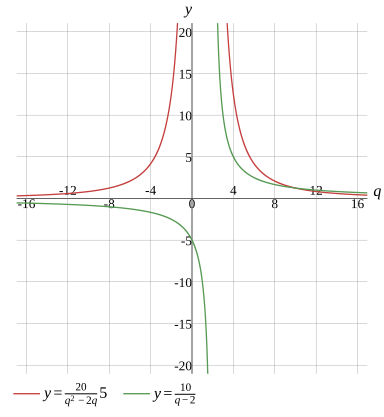Question
Solve the equation
q=10
Evaluate
q2−2q20×5=q−210
Find the domain
More Steps


Evaluate
{q2−2q=0q−2=0
Calculate
More Steps


Evaluate
q2−2q=0
Add the same value to both sides
q2−2q+1=1
Evaluate
(q−1)2=1
Take the root of both sides of the equation and remember to use both positive and negative roots
q−1=±1
Simplify the expression
q−1=±1
Separate the inequality into 2 possible cases
{q−1=1q−1=−1
Calculate
{q=2q−1=−1
Cancel equal terms on both sides of the expression
{q=2q=0
Find the intersection
q∈(−∞,0)∪(0,2)∪(2,+∞)
{q∈(−∞,0)∪(0,2)∪(2,+∞)q−2=0
Calculate
More Steps


Evaluate
q−2=0
Move the constant to the right side
q=0+2
Removing 0 doesn't change the value,so remove it from the expression
q=2
{q∈(−∞,0)∪(0,2)∪(2,+∞)q=2
Find the intersection
q∈(−∞,0)∪(0,2)∪(2,+∞)
q2−2q20×5=q−210,q∈(−∞,0)∪(0,2)∪(2,+∞)
Multiply the terms
More Steps


Multiply the terms
q2−2q20×5
Multiply the terms
q2−2q20×5
Multiply the terms
q2−2q100
q2−2q100=q−210
Cross multiply
100(q−2)=(q2−2q)×10
Simplify the equation
100(q−2)=10(q2−2q)
Rewrite the expression
10×10(q−2)=10q(q−2)
Evaluate
10(q−2)=q(q−2)
Calculate
More Steps


Evaluate
10(q−2)
Apply the distributive property
10q−10×2
Multiply the numbers
10q−20
10q−20=q(q−2)
Calculate
More Steps


Evaluate
q(q−2)
Apply the distributive property
q×q−q×2
Multiply the terms
q2−q×2
Use the commutative property to reorder the terms
q2−2q
10q−20=q2−2q
Move the expression to the left side
10q−20−(q2−2q)=0
Calculate
More Steps


Add the terms
10q−20−(q2−2q)
If a negative sign or a subtraction symbol appears outside parentheses, remove the parentheses and change the sign of every term within the parentheses
10q−20−q2+2q
Add the terms
More Steps


Evaluate
10q+2q
Collect like terms by calculating the sum or difference of their coefficients
(10+2)q
Add the numbers
12q
12q−20−q2
12q−20−q2=0
Factor the expression
More Steps


Evaluate
12q−20−q2
Reorder the terms
−20+12q−q2
Rewrite the expression
−20+(10+2)q−q2
Calculate
−20+10q+2q−q2
Rewrite the expression
−10×2+10q+q×2−q×q
Factor out −10 from the expression
−10(2−q)+q×2−q×q
Factor out q from the expression
−10(2−q)+q(2−q)
Factor out 2−q from the expression
(−10+q)(2−q)
(−10+q)(2−q)=0
When the product of factors equals 0,at least one factor is 0
−10+q=02−q=0
Solve the equation for q
More Steps


Evaluate
−10+q=0
Move the constant to the right-hand side and change its sign
q=0+10
Removing 0 doesn't change the value,so remove it from the expression
q=10
q=102−q=0
Solve the equation for q
More Steps


Evaluate
2−q=0
Move the constant to the right-hand side and change its sign
−q=0−2
Removing 0 doesn't change the value,so remove it from the expression
−q=−2
Change the signs on both sides of the equation
q=2
q=10q=2
Check if the solution is in the defined range
q=10q=2,q∈(−∞,0)∪(0,2)∪(2,+∞)
Solution
q=10
Show Solution

Graph
